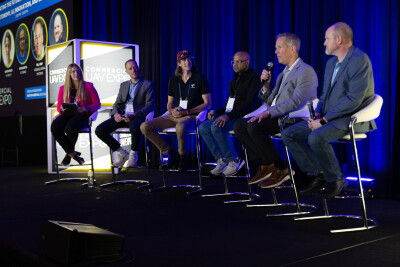Nearly everyone in the UAV industry has heard some variation of the phrase, “It’s not about the drone, it’s about the data,” at one time or another. Now, that common mantra is taking on an entirely new meaning as the boom around artificial intelligence continues to transform our use of data across sectors. Many professionals have seen this development lead to more quality and efficient decision-making.
At this year’s Commercial UAV Expo, a session entitled It’s Not About the Drone (or the Data), It’s the Decision covered this very topic in a panel discussion featuring industry experts. The conversation was moderated by Katy Milner, a partner with Hogan Lovells LLP, and featured the following speakers:
- Ben Stocker, Senior Construction Technologist, Skender
- Kara Fragola, Field Engineer, Skanska USA Civil
- Keaton Denzer, Chief UAS Pilot, Bechtel
- Mike Winn, Co-Founder and CEO, DroneDeploy
The conversation began with a discussion about what types of data these practitioners are using, with some real-life examples of how this data has positively impacted their work. A lot of that portion of the conversation revolved around various photos, videos, and 360-degree imagery, all of which can be utilized to create crucial 3D models and orthomosaics. With this base map of a job site, all kinds of efficient workflows are introduced.
The panel also discussed the increased usage around the cloud, really democratizing the data, as Stocker puts it. Denzer spoke to a lot of this as well, specifically around the ease of sharing the data. Regardless of the types of data being collected and shared, he said, stakeholders can “just go in and do the measurements, get the visuals, right in the [web-based] platform, and there isn’t as much of this exporting into different softwares.”
Attendees of this session also got to hear about some real-world examples of how this data they had been collecting has benefited them on the job. That included discussions about underground utility mapping, facade inspections, and monitoring changes over time. Additionally, Fragola talked about how they were called upon to help the response effort after the tragic Key Bridge collapse earlier this year. Flying UAVs over and around the site, responders were able to have a quick and easy view of the scene from which they could base their next moves.
From there, the conversation moved over to artificial intelligence as Winn explained some of the ways DroneDeploy’s features leveraging the tool. He showed off some slides to give tangible examples of how this worked for a variety of use cases, including in agriculture. There, drones can fly over corn fields and use AI built into DroneDeploy’s platform to automatically count the number of stalks growing.
Winn said, “What’s interesting here is that, for so long there was all of this AI hype. Now it’s actually turning into real tools that help companies make money.”
From the end user perspective, there were a handful of examples about how AI usage is already starting to provide benefits to their firms. Stocker mentioned broadly that it’s crucial to have as much historical data as possible to make these tools work, and that we’re still in the early stages of how valuable they can be. Even today, though, Fragola relayed that AI is helping tremendously in catching potential errors early to avoid costly and stressful rework. Denzer also clarified that AI is not going to be something that replaces workers, but helps.
Looking to the future, there are so many exciting possibilities for how AI is going to power future workflows. Denzer mentioned, for example, enabling true autonomy to open up even more potential for drone operators to improve their ROI. Stocker mentioned some of the new 3D modeling tools that have come out in recent years like NeRFs and Gaussian Splats, which both utilize AI and machine learning to create 3D representations with far fewer images than traditional photogrammetry. Fragola finished up that segment by mentioning how connections with Internet of Things (IoT) sensors are providing even more data into the models that are created with drone imagery and scanning.
Coming out of the session, it’s clear that the data being collected by drones in various industries are already providing huge amounts of value, and that is only increasing with the improvements around artificial intelligence. For drone operators looking to streamline their operations, now is the time to start adoption of these tools.















Comments